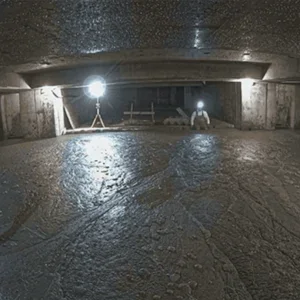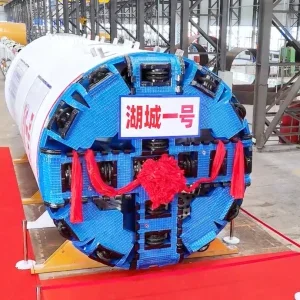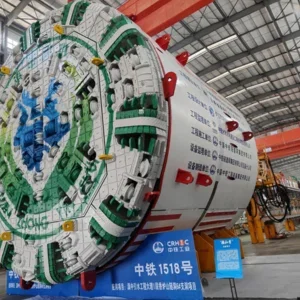The results were announced at a banquet ceremony following the Tunnelling Asia Conference, organised by the Tunnelling Association of India, in Mumbai.
The winners are:
Major Project of the Year (over €500m): EOLE – Paris East-West Rail Express Link, France

Claudio Dias is Young Tunneller of the Year 2023
EOLE is a 55km expansion of the current E line of the RER (Regional Express Network), connecting the existing St Lazare Station – the second busiest station in Europe with more than 450,000 passengers/day, in the heart of Paris – to the western metropolitan region. The link is due to open mid-2024, on time for the Paris Olympic Games.
Project of the Year (between €50m and €500m): Shenzhen Binhai Avenue (Headquarters Base Section) Coastal Wide Underground Space, China

Prefabrication and Assembly Construction Technology for Metro Stations, winner of the Technical Innovation of the Year, is a new construction method for underground metro stations
The Binhai Avenue Tunnel, approximately 1.56km long, is laid flat and shallowly buried on the main and auxiliary tracks, with in situ sinking and stacking layout. The south and north auxiliary roads of the subsidence-style tunnel are arranged in staggered layers. The “two-in and two-out” special ramps are set up respectively in combination with the development of the Super Headquarters base to connect the Super Headquarters underground road network system. This creates an underground three-level road system of “underground express road + underground ring road + plot garage” to accommodate the large-scale traffic demand of the Super Headquarters base and create an efficient underground transport system.

Project of the Year including Renovation (up to €50m) went to Mount Royal Tunnel – Double Arch Replacement & Rehabilitation for the REM Project, Canada
Project of the Year including Renovation (up to €50m): Mount Royal Tunnel – Double Arch Replacement & Rehabilitation for the REM Project, Canada
A section of the REM goes through the 5km-long existing Mount Royal Tunnel, which was completed in 1917 and connects the downtown area with the north side of Montreal. After 100 years of continuous operation, the tunnel was expected to require repair and upgrade for conversion to an LRT facility.
The project addresses the concerns from detailed inspections and strength assessments concluding that the South Section (92m) was not in an acceptable condition after 100 years of deterioration caused by infiltration of chloride-laden groundwater. Another 290m, named North Section, was considered in an adequate condition to be remedied using observational rehabilitation methods.
Technical Innovation of the Year: Building Blocks in a Foundation Pit – Prefabrication and Assembly Construction Technology for Metro Stations, China
Prefabrication and Assembly Construction Technology for Metro Stations is a new construction method for underground metro stations, using precast concrete structural components and assembling them like ‘building blocks’ on site in a foundation pit, to assemble quickly into tunnel structures, minimising on-site construction activities.
The technology was originally developed to solve the problem of constructing open-excavated metro stations in severely cold weather in Changchun, by using an industrialised construction method. Project experience has demonstrated it also has advantages in other environmental conditions.
Product/Equipment Innovation of the Year: Hard Rock Shield + Earth Pressure + Slurry three-mode TBM, China
The 1.9km section of Phase 2, Line 7 of the Guangzhou Rail Transit between Luogang station and Shuixi station has a depth of 19.73m, 600m minimum radius of curve, and 28% maximum gradient. The tunnel's outer diameter is 6m, and inner diameter 5.4m. The engineering geology is complex and variable. The TBM bored mainly through granite residual soil, boulder, upper-soft and lower-hard rocks, and full-section hard rocks, with high strength of rock stratum (up to 140Mpa), and relatively developed boulder (66.7%).
The alignment travels under important buildings and structures such as the airport high-pressure oil pipeline, tram line 1, and existing operating subway tunnels. The use of dual-mode TBM or mining methods could easily cause settlement of the surface, buildings and structure, without the overall risk being controlled. The hard rock shield + slurry + earth pressure three-mode TBM can effectively reduce risk, and control settlement of the earth's surface and surrounding structures during tunnelling.
Beyond Engineering: Permanent sprayed concrete linings on Mumbai Metro Line 3 Sahar Road crossover cavern, India
The Sahar Road Crossover Cavern is a stepped profile cavern on the Mumbai Metro Line 3 project, and comprises six different cross-sections, symmetrical about the middle of the cavern.
The original design called for a conventionally reinforced, cast in situ secondary lining. Because of the number of geometrical sections and complexity of staging the works, however, Mumbai Metro Rail Corporation opted to explore the use of sprayed waterproofing membranes and permanent fibre reinforced sprayed concrete linings (PSCL) as well as development of a ‘drained regulating layer’ concept which allowed the application of sprayed waterproofing membranes in wet conditions. This was a first for any metro project in India, with the latter considered an international first.
Young Tunneller of the Year: Cláudio David Cabral Dias, Portugal
Cláudio Cabral Dias is a Portuguese tunnel engineer currently based in Madrid and working at Ayesa, as a principal tunnel engineer. He is 34 years old and has over 10 years of international tunnelling experience, having lived and worked in Portugal, Brazil, the UK, and Spain.
In September 2014, he joined CH2M (now Jacobs) as a tunnel design engineer in London and started working on the Ipswich Cable Diversion Works, the National Grid Tunnels, and the Tottenham Court Road London Underground Station Upgrade. In May 2015, he was seconded to Crossrail as a field tunnel engineer for Fisher Street crossover tunnels and caverns site.
Then followed a period as CAT 3 reviewer for the Purple Line of Los Angeles Metro before he moved on to the detailed design of Hinkley Point C Marine Works, as lead 3D modeller and as package manager for cast in situ lining. In May 2018, he joined Typsa, as a senior tunnel engineer for the HS2 London contracts, to work for a design JV of Typsa, Arup and Strabag. Here he was SCL design manager, responsible for the 10-person team designing four ventilations shafts.
In December 2020, Dias joined Ayesa and was recently promoted to head of ground engineering and tunnelling, with the responsibility to lead and grow the tunnelling team of the company based in Madrid, Spain.







